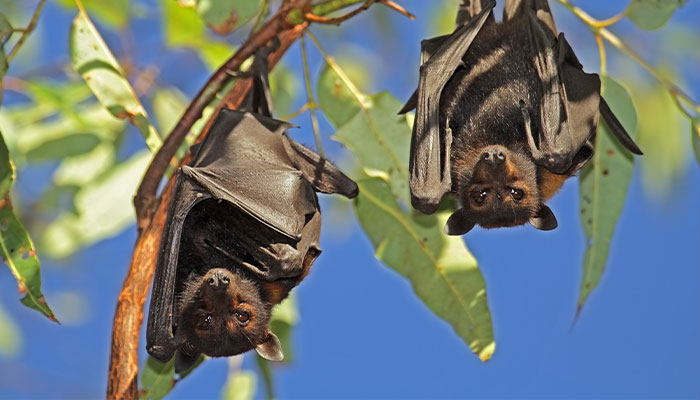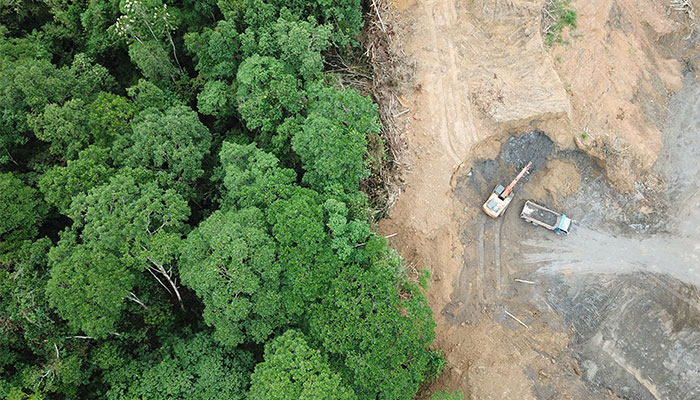The World Health Organisation team currently in China is expected to find that SARS-CoV-2 (the virus which causes COVID-19) originated in animals – that bats and possibly pangolins made us sick. But if this is confirmed, what can we do? Can we prevent such a devastating outbreak happening again?

Carriers: Black flying foxes in Kakadu National Park ... a bat-borne virus led to COVID-19, just as Australia's killer Hendra virus originated in bats.
Fortunately, the short answer is ‘yes we can’.
In the scientific community, there is widespread agreement that the best way to deal with this type of animal threat to human health is by taking what is called a One Health approach.
This approach is grounded in a pretty straightforward idea – that the health of humans, animals and the environment are linked. Basically, healthy animals and a healthy environment contributes to a healthy human population.
The COVID-19 pandemic has dramatically highlighted how animals can affect human health. Yet as strange and alarming as it may sound, this kind of transmission is not an isolated event.
This approach is grounded in a pretty straightforward idea – that the health of humans, animals and the environment are linked.
Estimates suggest that at least 70 per cent of emerging and re-emerging infectious diseases that threaten human health originate in animals, and over half of the pathogens that are established in human populations come from an animal source.
Setting aside numbers from the current pandemic, it is believed that globally at least 15 million people die every year as a result of zoonoses (diseases that are transmitted from animals to humans).
This is a significant problem that will only worsen with climate change.
Animals, humans in closer contact
One Health looks to address the ‘upstream’ drivers of disease to prevent outbreaks happening in the first place.

Causes: Land clearing for a growing population has destroyed habitat, bringing humans and animals into closer contact.
To understand how this plays out we could take as an example Australia’s very own bat-borne virus, which emerged in the Brisbane suburbs in 1994. Hendra virus can cause disease in people, horses and even dogs. It is extremely rare, but its consequences for humans and horses are catastrophic.
One reason Hendra virus has spread is because humans, horses and bats have been forced into closer contact. Land clearing to make way for a growing population has meant the destruction of flying fox habitat and more opportunities for disease transmission.
Habitat loss is also linked to the expansion and intensification of agriculture around the world, so that modern farming practices are another upstream cause of disease.
We could simply kill animals to reduce the threat they pose. Or maybe there are other options that could be pursued.
Large numbers of animals (especially pigs and chickens) forced to live in close proximity create ideal conditions for the emergence and spread of disease. This can be seen in past outbreaks of swine flu and avian influenza.
After understanding these links it might be tempting to circumvent the hard work suggested by One Health, of pushing for deeper societal change around population growth, development practices and even eating habits, and adopt an easier strategy.
Perhaps in the case of Hendra Virus we could simply kill animals to reduce the threat they pose. And in fact culling of flying foxes has been suggested as a way of eradicating Hendra Virus.
Or maybe there are other options that could be pursued.
Killings not the answer
One Health recognises that diseases need the right conditions to be transmitted so that how humans and animals come into contact with each other and the environments in which they do so, matters for how easily disease can spread.
Agricultural practices that reduce the risk of diseases passing from animals could be used. For example in China, multi-storey pig farms have been built which limit contact between people and other animals.
For those of us fortunate enough to live in a country like Australia, COVID-19 has provided a chance to pause and take stock.
However if we sit back for a moment, there are some significant ethical costs associated with these kind of measures. And they also seem to miss the point of One Health.
In the case of culling the relevant animals (the black flying fox and the spectacled flying fox), killing sentient creatures (and native ones at that) just because they might be a source of disease in the future, seems hard to justify ethically.
It also turns out to be hard to justify practically. Attempting to eradicate just these two species of flying fox is unlikely to be successful and may in fact make the problem worse, as stressed bats shed more virus.
- Revealed: the best trees for shading hot Sydney school yards
- 'Good for the soul': The PM who loved poetry
In the case of industrial agriculture, deliberately designing systems that prevent the most basic contact between workers and the animals in their ‘care’ seems like a fundamental abrogation of our responsibilities to intelligent and vulnerable creatures.
For those of us fortunate enough to live in a country like Australia, COVID-19 has provided a chance to pause and take stock. While we congratulate ourselves on coming up with a vaccine in record time, let’s hope we don’t lose the opportunity to think about and implement the kind of changes scientists have advocated through One Health.
Though these changes may be hard, they are surely preferable if they avoid us having to perform this record-breaking feat again, and again, and …
Dr Jane Johnson is a field philosopher who investigates questions in science and medicines. She is a Lecturer in the Department of Philosophy at Macquarie University.



